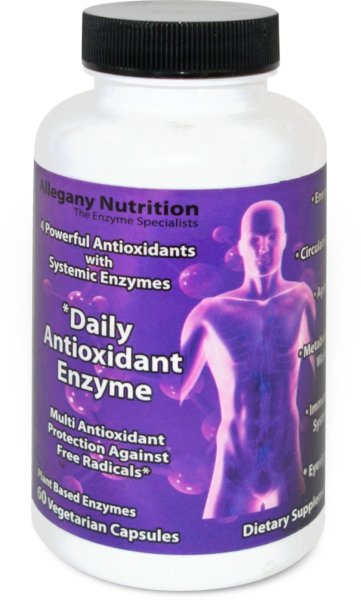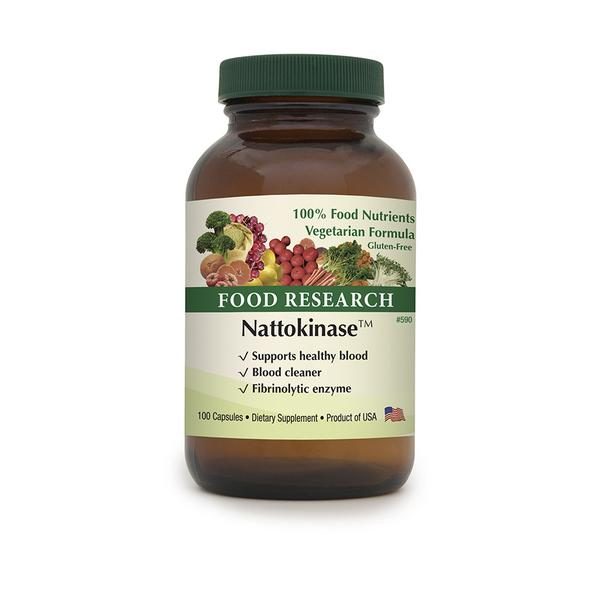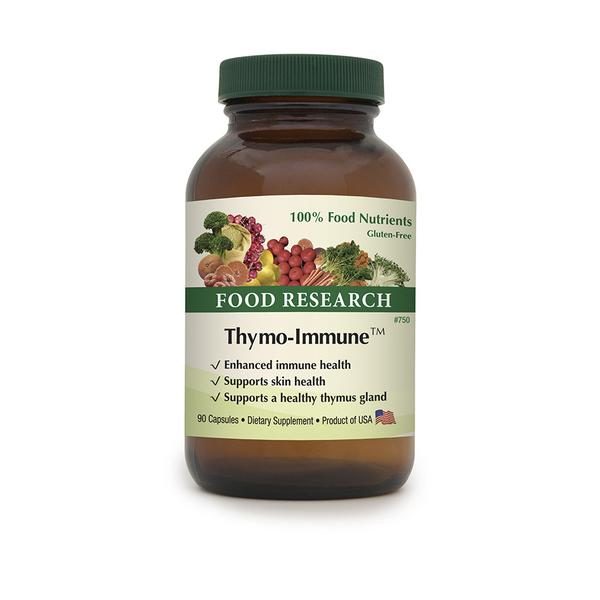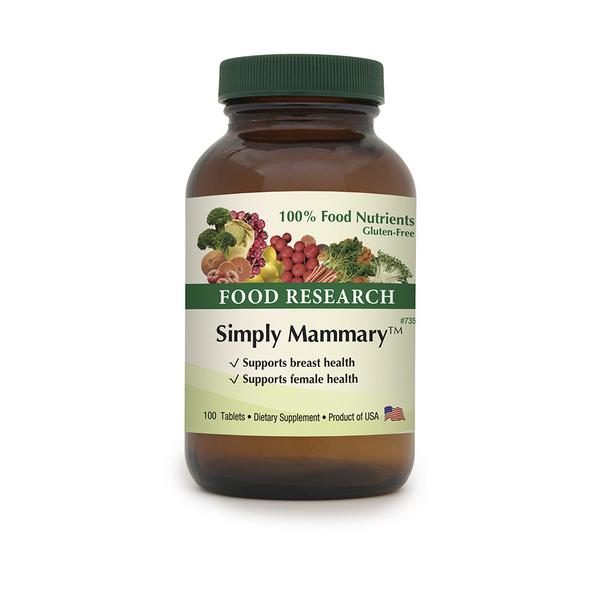The Daily Antioxidant Enzyme contains 4 powerful antioxidants with 4 different systemic enzymes to support optimal health and vitality.
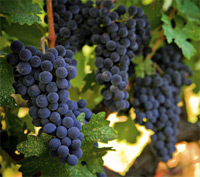 Grape Seed Extract (Gravinol S®) is believed to be one of the most powerful antioxidants ever found.* Many feel it has antioxidant and chemoprotective properties to fight against free radicals and oxidative stress. Grape Seed Extract provides a highly concentrated source of oligomeric proanthocyanidins (OPC’s) which are believed to possess a broad spectrum of biological, antioxidant and cardioprotective properties.* This extraordinary nutrient is believed to be 50 times more potent than vitamin E and 20 times more potent than vitamin C as a free radical scavenger.* OPC’s are thought to be 100% bioavailable in humans, with the ability to be found in the blood within 20 minutes.* OPC’s are also thought to have a unique ability to cross the blood brain barrier and provide direct protection to the brain and central nervous system.*
Grape Seed Extract (Gravinol S®) is believed to be one of the most powerful antioxidants ever found.* Many feel it has antioxidant and chemoprotective properties to fight against free radicals and oxidative stress. Grape Seed Extract provides a highly concentrated source of oligomeric proanthocyanidins (OPC’s) which are believed to possess a broad spectrum of biological, antioxidant and cardioprotective properties.* This extraordinary nutrient is believed to be 50 times more potent than vitamin E and 20 times more potent than vitamin C as a free radical scavenger.* OPC’s are thought to be 100% bioavailable in humans, with the ability to be found in the blood within 20 minutes.* OPC’s are also thought to have a unique ability to cross the blood brain barrier and provide direct protection to the brain and central nervous system.*
Resveratrol 50% (From Knotwood) is a member of a group of plant compounds called polyphenols. These compounds are thought to have antioxidant properties, protecting the body against the kind of damage linked to increased risk for conditions such as cancer and heart disease.* Resveratrol is found in the skin of red grapes, but other sources include peanuts and berries. The resveratrol in the Daily Antioxidant Enzyme is an all-natural, high-potency standardized extract of 50% trans-resveratrol. University studies show that resveratrol is an antioxidant, cardioprotectant, and antimutagenic agent.*
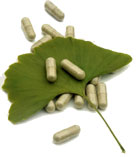
Ginkgo Biloba Extract (Gbe-24/6®) out weighs all other Ginkgo Biloba’s. It has a minimum of 24% Ginkgo Flavone Glycosides, at least 6% terpene lactones, more than 0.8% Ginkgolide B, and less than 1 PPM of Ginkgolic acid. Ginkgo Biloba is believed to be an herb with powerful antioxidant effects in the brain, retina, and cardiovascular system.* Ginkgo Biloba Extract is also believed to enhance mental acuity and memory, increase circulation in the brain and to the extremities, potentially inhibit the oxidative events leading to the progression of Alzheimer’s and pre-senile dementia.* Many believe it can facilitate the removal and suspension of plaque off of the arterial walls, and inhibit platelet aggregation.*
Astaxanthin (Haematoccus Lupvialis) – Natural (AstraReal®) is found all over the world, from African lakes to Arctic snowfields. The basic natural source comes from a remarkable microalga – Haematococcus pluvialis. Marine animals feed on Haematococcus and we see the accumulation of astaxanthin as a red to orange color in salmon flesh, cooked lobster, shrimp and many more marine animals.
Astaxanthin is a lipid soluble (Oil Soluble) carotenoid antioxidant.* Upon ingestion astaxanthin may be found in all organs of the body.* It is believed that astaxanthin accumulates in the membranes of cells and in the membranes of mitochondria. Astaxanthin has a unique structure that enables the molecule to span the double layer membrane and consequently, exposes itself both to the interior as well as the exterior of the cell.* By localizing itself in the membranes, astaxanthin may protect membrane components like proteins and unsaturated fatty acids from oxidation.*
Systemic Enzymes are included in this formula to help provide cellular energy and to help increase the bio-availability of the nutrients.* Catalase is the antioxidant enzyme of the 4 enzymes in the Daily Antioxidant Enzyme. The protease, amylase and lipase are included to help cleanse the blood of undigested particles such as proteins, fats, and carbohydrates.*
Catalase is an important systemic enzyme to our health.* The catalase enzyme is found in nearly every living organism on the planet that is exposed to oxygen. This antioxidant enzyme can catalyze the conversion of hydrogen peroxide into water and oxygen. Hydrogen peroxide is a by-product of cellular metabolism. Catalase has one of the highest rates of turnover when compared to all other enzymes. In other words, one catalase enzyme may change up to 40 million molecules of hydrogen peroxide into water and oxygen in just one second. Catalase enzymes are believed to protect our cells, counteracting and balancing the continual production of hydrogen peroxide.* In addition to acting as a super antioxidant, catalase also has the ability to use hydrogen peroxide to oxidize toxins including methanol, ethanol, formic acid, formaldehyde, and nitrite.* This type of dual activity makes it a crucial cellular enzyme and antioxidant.*
| Price | $46.00 |
Description
Water & Fat Soluble Antioxidants
The Daily Antioxidant Enzyme contains both water and fat soluble antioxidants. Water-soluble antioxidants perform their actions in the fluid inside and outside of the cells, whereas fat-soluble antioxidants act primarily in cell membranes. Cell membranes control the movement of substances in and out of the cell. Therefore the Daily Antioxidant Enzyme has the ability to work in all three crucial areas.
Clinical Benefits of Astaxanthin
Clinical Benefits of Astaxanthin in regards to Cardiovascular Disease:
- Improves blood lipid profile.
- Reduces oxidative stress.
- Enhances capillary circulation.
Cardiovascular diseases (CVDs), including heart attack and stroke, are the leading cause of death globally. According to WHO, 17.3 million people died from CVDs in 20081. Of those, an estimated 7.3 million deaths were due to coronary heart disease and 6.2 million were due to stroke.
Behavioral risk factors such as smoking, unhealthy diet, and alcohol abuse are believed to be responsible for 80% of coronary heart disease and cerebrovascular disease2.
Moreover, these behaviors result in increased body weight, elevated blood pressure, dyslipidemia, insulin resistance, and hyperglycemia. These effects are associated with the development of atherosclerosis, which is the main underlying cause of heart attack, stroke, and peripheral vascular disease.
Oxidative stress and inflammation are widely recognized as contributing factors to atherosclerotic CVDs. The use of antioxidants such vitamin E, C, and beta-carotene as preventive therapies for CVDs has yielded mixed results. This is why astaxanthin, which is a much stronger antioxidant that also exhibits anti-inflammatory properties, is now being investigated as a promising compound for protecting against atherosclerotic CVDs. Studies have shown that natural astaxanthin reduces oxidative stress and inflammation, improves lipid profiles, promotes better blood flow in capillaries, and lowers blood pressure in hypertensive individuals. Importantly, no adverse effects have been reported in these studies.
A large body of clinical and experimental research strongly suggests that astaxanthin can contribute to improved cardiovascular health. For more details on how natural astaxanthin can help support and maintain good cardiovascular health, please contact us for an expanded version of this digest.
Clinical Benefits of Astaxanthin in Regards to Computer Vision Syndrome
- Relieves eye fatigue symptoms by improving capillary blood flow circulation.
- Improves the quality of vision by preserving the “zoom-in & zoom-out” refocus of the eye ciliary muscle.
- Relieves eye inflammation and shoulder stiffness in heavy PC workers.
On average, workers and adolescents in modern cities spend over 45 hours every week staring at computer screens, playing video games, watching television, or interacting with smart phones. The U.S. National Institute of Occupational Safety and Health found that over 88% of office workers report eyestrain. A European study showed that 23% of Swedish schoolchildren experience eye fatigue due to playing video games excessively. This widespread use of visual displays increases stress on the eyes, which leads to a complex ophthalmic and psycho-physical condition called computer vision syndrome (CVS). Symptoms of CVS include eye strain, sensitivity to glare, sore eyes, blurred vision, and neck and shoulder pain. CVS also causes mood swings, irritability, physical burnout, headaches, and a consequent decline in mental performance, motivation, and interpersonal efficacy.
Clinical Benefits of Astaxanthin in Regards to Revealing Your Skin’s Natural Beauty
- Revitalizes photo aged skin by quenching oxidative stress and inflammation in all skin layers.
- Reduces the size of wrinkles and improves skin microtexture.
- Lightens age spots by inhibiting overproduction and oxidation of melanin.
When wrinkles or skin problems arise, most women reach for cosmetic products, like creams, gels, ointments, and makeup. Applying these products to the surface of the skin may temporarily conceal the problem, but their effect is superficial and doesn’t tackle the underlying causes. The skin is an extremely complex organ, consisting of multiple layers that each have unique and important functions. For a product to truly improve the skin’s health and beauty, it must provide protection and support to all layers of the skin.
Our skin is under constant attack from free radicals produced by UV rays, pollution, stress, and poor nutrition. The damage caused by free radicals is a major cause of skin aging and problems such as wrinkles and age spots. This free radical damage affects all layers of the skin, from the visible surface to the delicate deep layers where new skin is formed.
Natural algae astaxanthin is a powerful antioxidant with potent anti-inflammatory effects. Its unique molecular structure allows it to reside in the cell membrane and to protect the inside and outside of cells from free radical attack. Research shows that astaxanthin taken as an oral supplement is active in each of the skin’s layer, provides protection from UV damage, shrinks wrinkles, and makes age spots smaller. Natural algae astaxanthin can help your reveal your skin’s natural beauty from the inside out.
Clinical Benefits of Astaxanthin in Regards to Physical Performance & Muscle Function
- Boosts power output and Muscle endurance during training
- Lowers lactic acid, fatigue, and muscle soreness.
- Reduces muscle damage and inflammation.
- Improves blood flow and antioxidant status.
- Muscle metabolism improves fat utilization.
More than ever, people nowadays enjoy a wide variety of sports activities to maintain a healthy body weight and circulatory system. From lifestyle changes to elite athletes, fastidious training may not always bring desired results. Some may experience performance slumps or a decline of endurance. Specialized nutritional support is recognized to support physical performance in many ways. From isotonic drinks to protein and carbohydrates, natural astaxanthin nutritionally completes the demands of a physically active lifestyle.
During our physical activity, we require energy to move our body. And all energy we need are generated by mitochondrial cells, often referred to as the “power stations of the cell”, which provide as much as 95% of our body’s pure energy (primarily by the burning of muscle glycogen and fatty acids). Unfortunately, a portion of this energy produces highly reactive and damaging reactive oxygen species (ROS) which is one of the major factors to deteriorate our body. ROS leads the cause of cell damage by peroxidation of the cell membrane components, and oxidation of DNA and proteins. What we found from numerous studies and research, ROS also caused the inflammation of muscle tiredness and soreness. Improving your muscle performance and increasing its endurance are required to protect your physical condition from ROS damaging. In recent years, much attention was paid to the suppression of oxidative reaction by food with antioxidant. Vitamin C and vitamin E have been widely used as popular elements against oxidative stress now.
The most powerful antioxidant in the carotenoid group, Astaxanthin, provides a variety of benefits to the muscle function such as improvement of physical performance, lower muscle damage and the quality of blood.
Astaxanthin FAQs
What creates Reactive Oxygen Species (ROS)?
Where does Astaxanthin come from?
How does Astaxanthin compare to other antioxidants?
- 6000 times stronger than Vitamin C
- 3000 times stronger than resveratrol and quercitin
- 800 times stronger than CoQ10
- 560 times stronger than epigallocatechin-gallate
- 75 times stronger than alpha-lipoic acid
How does Astaxanthin work?
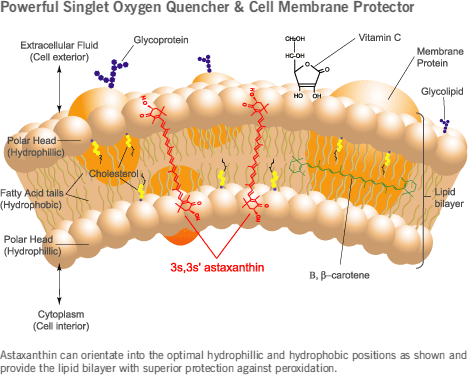 Astaxanthin is a lipid soluble carotenoid antioxidant. Upon ingestion astaxanthin can be found in all organs of the body. At the cellular level astaxanthin accumulates in the membranes of cells and in the membranes of mitochondria and many others. Astaxanthin has a unique structure that enables the molecule to span the double layer membrane and consequently, exposes itself both to the interior as well as the exterior of the cell. By localizing itself in the membranes, astaxanthin protects membrane components like proteins and unsaturated fatty acids from ROS mediated oxidation. Furthermore, this high antioxidant capacity can inhibit the activation of the proinflammatory response via the NF-kB dependent pathway.
Astaxanthin is a lipid soluble carotenoid antioxidant. Upon ingestion astaxanthin can be found in all organs of the body. At the cellular level astaxanthin accumulates in the membranes of cells and in the membranes of mitochondria and many others. Astaxanthin has a unique structure that enables the molecule to span the double layer membrane and consequently, exposes itself both to the interior as well as the exterior of the cell. By localizing itself in the membranes, astaxanthin protects membrane components like proteins and unsaturated fatty acids from ROS mediated oxidation. Furthermore, this high antioxidant capacity can inhibit the activation of the proinflammatory response via the NF-kB dependent pathway.Why Astaxanthin is Mother Nature’s Most Powerful Anti-aging Molecule?
- Strongest Singlet-Oxygen Quencher among anti-aging molecules.
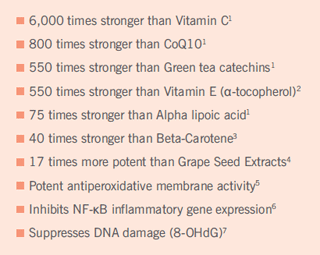
- Protective Effect of Natural Antioxidants on Human Fibroblasts Astaxanthin vs. other antioxidants Human dermal fibroblasts were pre-incubated with antioxidants before exposure to singlet oxygen, and cell viability was measured to compare the protective efficacy.
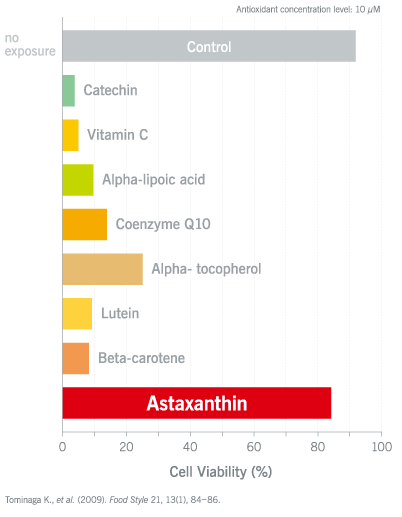
- Purest Antioxidant Molecule because it has no-proxidant activity even when subjected to enormous amount of stress from environmental factors and free radicals.
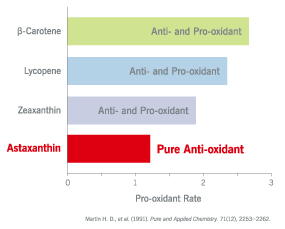
- Provide a Unique Membrane Protection because with its longs chain structure and polar end groups can span the bilayer membrane incrementing resilience against oxidative stress. Astaxanthin quench free radicals both in the water and fat loving zone of the membrane in contrast to most antioxidants, which work either in the inner (Vitamin E and Beta Carotene) or outer (Vitamin C) side of the membrane.

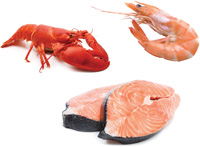 Provides Superior Mitochondria Protection as research shows that is 1,000 times more effectively than Vitamin E against lipid peroxidation in the mitochondria
Provides Superior Mitochondria Protection as research shows that is 1,000 times more effectively than Vitamin E against lipid peroxidation in the mitochondria- Synergies and protect our endogenous antioxidants from early degradation
- Reduce DNA Damage and premature cell death caused by oxidation and plasma C-reactive oxygen
- Cross Brain-Retinal Blood Barrier leading to neuro-protective effects and alleviation of eye fatigue.
- Powerful Anti-Inflammatory – Several in-vitro and in-vivo studies shows that ASX strongly suppressed nuclear translocation of NFkB inflammatory cascade, which are the leading cause of most degenerative diseases.
Astaxanthin for Dyspepsia and Helicobacter Pylori?
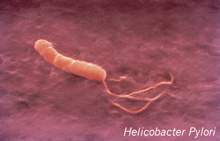
Dyspepsia is the general term given to a variety of digestive problems localized in the upper abdominal region. Typical symptoms for example include stomach pain, gas, acid-reflux or bloating. Dyspepsia is like the stomach version of the irritable bowel syndrome and its symptoms may appear at any age or to any gender. The medical approach to dyspepsia involves looking for treatable causes and addressing them if identified. Failing that, doctors suggest treatments by trial-and-error. The problem associated with this non-standardized approach involves drugs that may not work, may cause side effects and exacerbate the patient’s condition brought on by stressful attempts to cure symptoms. To understand the benefits of astaxanthin in dyspepsia, it is necessary to categorize specific types; most common forms are either non-ulcer dyspepsia or gastric dyspepsia. Non-ulcer dyspepsia problems usually do not have an identifiable cause, but fortunately, for most cases it is non-disease related and therefore temporary. On the other hand, gastric type dyspepsia is more severe and linked to identifiable causes. For example, the bacterial infection of Helicobacter pylori is a commonly known cause. Pathological symptoms of H. pylori infection include high levels of oxidative stress and inflammation in the stomach lining and symptoms like gastric pain and acid reflux., H. pylori can contribute to mild and severe kinds of symptoms, but on the other hand, people who are H. pylori positive can remain asymptomatic whereas others may develop into clinical problems. It is still unclear what triggers the severe form of infection and how the bacteria is passed on, but scientists suggested using strong antioxidants like astaxanthin for therapy and better long term protection.
Astaxanthin and Hypertension?
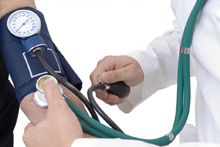
Epidemiological and clinical data suggest that dietary carotenoids such as astaxanthin may protect against cardiovascular disease (CVD) which includes hypertension. This condition is associated with blood vessel dysfunction, altered contractility and tone; mediated by relaxant (nitric oxide NO; prostacyclin) and constrictor factors (thromboxane; endothelin) in the blood. Furthermore, blood flow properties serve an important role in the pathological complications seen in atherosclerosis and coronary heart disease. Research presented here suggests that astaxanthin may be useful as part of an antioxidant therapy to alleviate hypertension.
Astaxanthin and Diabetes?
Draining the World Wealth
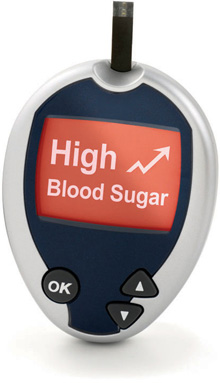 Diabetes mellitus is a worldwide epidemic that is critically linked to prevalence of obesity. More than 220 million people have diabetes and by the year 2030 the figures are expected to grow to 360 million. The diabetes is aggressively growing in both emerging and developed country. According to WHO, the Asian continent has over 90 million people suffering from diabetes – India (40 million) China (29 million); Indonesia (13 million) and Japan (7 million). The prevalence of diabetic patients remains pervasive in USA (22 million), Brazil (6 million), Pakistan (8 million); Russia (6 million); Italy (5 million) and Turkey (4 million). Even in the African region over 10 million people suffer from diabetes, especially in Nigeria where it is expected to reach 5 million within the year 2030.
Diabetes mellitus is a worldwide epidemic that is critically linked to prevalence of obesity. More than 220 million people have diabetes and by the year 2030 the figures are expected to grow to 360 million. The diabetes is aggressively growing in both emerging and developed country. According to WHO, the Asian continent has over 90 million people suffering from diabetes – India (40 million) China (29 million); Indonesia (13 million) and Japan (7 million). The prevalence of diabetic patients remains pervasive in USA (22 million), Brazil (6 million), Pakistan (8 million); Russia (6 million); Italy (5 million) and Turkey (4 million). Even in the African region over 10 million people suffer from diabetes, especially in Nigeria where it is expected to reach 5 million within the year 2030.
Diabetic complications lead to heart disease (approximately 65% of death amongst diabetics), blindness, kidney failure and amputations. As a result, the indirect and direct medical expenditure of diabetics represent almost 5 times that of a non-diabetic.
Type 2 Diabetes: A Preventable Disease
In most cases, diabetes is treated with medication, although about 20% of diabetics may be managed by lifestyle changes. This means that even if we cannot change the genetic influences, fortunately, for most of us diabetes is preventable; for example, making dietary changes, taking nutritional supplements and exercising. To highlight this, people in high risk groups who achieve a 5-7% cut in body weight will reduce risk of developing diabetes approximately 58% across all age and ethnic groups.
While the debate between the contributory effects of carbohydrate and fat intake continues unabated, research reveals a strong link between foods with high glycemic index and prevalence of type 2 diabetes. Excess blood glucose needs to be converted by insulin (produced by the pancreas ß-cells) into glycogen stores, however, when glycogen stores are full, glucose is converted into fat. Over time, the body’s cells may eventually become desensitized to insulin making it necessary to produce more insulin to achieve the same affect. It is this process that would eventually lead to a state known as hyperinsulinaemic state. As a result, the body loses its ability to control high blood glucose levels (hyperglycemia) that could result in toxic conditions and promote further complications such as kidney failure.
CAPSULES PER BOTTLE: 60 vegetable capsules.
SUGGESTED SERVING SIZE: 1 Capsule
Directions: As a dietary supplement, adults take 1 capsule in the morning and 1 capsule mid-afternoon preferably on an empty stomach. Depending on individual needs, or as directed by your Health Care Professional. Contains no corn, dairy, gluten, soy, sugar or fillers.
